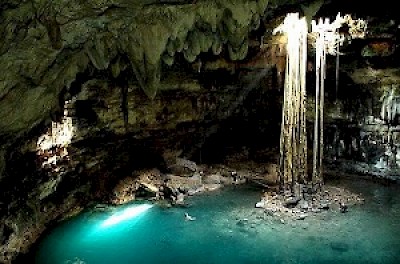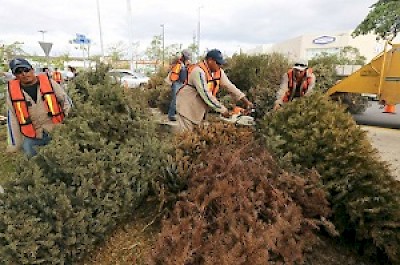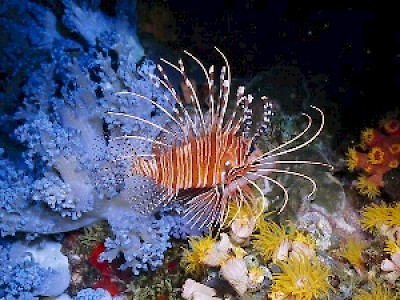Yucatan News: Lobsters and Bees
Cenotes are Becoming Contaminated
As populations grow in Yucatan, and especially in Merida, so does the pressure on the clean water supply. While Yucatan has no above-ground rivers, there are approximately 400 rivers, with 2,660 cenotes, that run through and/or under the limestone shelf on which we all live. There are 85 cenotes in Merida alone. Until recently, a sparse population gave ground water time to percolate through the layers of limestone and what we ended up with was relatively good water even before water ran through the growing number of treatment centers. However, due to tourism and a staggering number of people moving to Yucatan to go to school, find work, or flee from violence in their home states, Yucatan has several municipalities that have more pressure from populations than do others. These include Merida, Valladolid, Tizimin, Progreso and Ticul. It must also be remembered that our crops and animal herds could soon be affected as well. Right now, the biggest source of pollution is coming from septic tanks, so a move is underway to have all new wells drilled to a minimum of 30 meters below the surface. Additional collaborative projects are going on at the Temporary Collection Center at the South Uu’um Tsil Metropolitan Ecological Park. The future value of a clean water supply is not lost on Yucatan, nor on expats. Look for more eco-friendly tourism and an even greater degree of cooperation among all of the residents of this state in the days to come.
Merida Collects Christmas Trees Again
Merida begins collecting Christmas Trees on the day after Three Kings Day (a.k.a. Epiphany). This program runs from January 7 through January 31. Residents are encouraged to donate their Christmas trees at one of twelve collection points throughout the city. They will then be processed into compost and given to families who need the compost for the sustainable backyard gardening programs. The collection points will be open Monday through Friday, 8:00 AM to 5:00 PM, and 8:00 AM to 1:00 PM on Saturdays. If you choose, you may have your tree picked up by your regular garbage collector, but the fee is $20 pesos.
Collection points for Christmas Trees in 2015 include:
• Parque de la Xtabay
• Parque “Los Cantaritos” (del Fraccionamiento Francisco de Montejo)
• Sam’s Club Montejo
• Prolongación del Paseo de Montejo con calle 33 (de la Colonia Gonzalo Guerrero)
• Animaya
• Centenario
• Mercado San Roque (de la Colonia San José Tecoh)
• Servicios Públicos Oriente (Colonia Emilio Portes Gil)
• Servicios Públicos Poniente (Fraccionamiento Yucalpetén)
• Sam’s Club avenida Aviación (Colonia Obrera)
• Sam´s Club (de la Avenida Correa Rachó y Calle 31 de la Colonia Díaz Ordaz)
• Parque de Monterreal (en la Calle 22 con 37 de esa Colonia)
• Parque Recreativo Oriente (en la Calle 10 con 55 y 57 del Fraccionamiento Del Parque)
Africanized Bees
Rogers Hall College had an incident in which at least a dozen individuals were stung by Africanized bees last week. Only two had a reaction bad enough to be life threatening, but help was quick to arrive and all twelve are doing fine at home. If you find aggressive bees on your property, call the police immediately. These bees must be removed and this is not a safe do-it-yourself project. Pets and vulnerable human population groups will be at risk until the swarm is completely eradicated by professionals.
Eight Undocumented Cubans Land in Progreso
A pregnant woman was among the small group of Cubans who made it past the Mexican Navy and the Port Authority last week, and were only found when the woman needed medical attention. Once all were discovered, they were transferred to Yucalpeten, where they received medical checkups and any necessary vaccinations. INM (the National Migration Institute) was called and will handle the case from this point forward. This was an extremely dangerous voyage, across the open sea, in a small, homemade boat. This group of refugees is lucky to be alive.
Canton Palace Remodeling
Canton Palace was originally the home of General Francisco Canton, a former Governor of Yucatan. It was built around the turn of the 20th century. By 1959, this magnificent building had become the Regional Museum of Yucatan. Today, just during the Christmas holidays, more than 8,000 visitors passed through its doors, almost 3,000 of whom made their visit between January 1 and January 6. With this kind of interest and devotion, it is past time for this gracious old lady to have a facelift. For the next few months, it may be a bit dusty at Canton Palace, but the exhibitions will continue. We suspect that the remodel itself will be worth more than one visit along the way.
Chichen Itza Light and Sound Show
The light and sound show at Chichen Itza is set up for 300 a night, but apparently over 600 people have been arriving in hopes of getting in. Since the trip to see a night show at Chichen Itza means an overnight stay for most people, its best to go to the website and register for your seat before taking a chance on not being able to get in. Noches de Kukulkan has a website, but let this stand as a warning: if you look at the trailer and at the slideshow, you are almost certain to move Heaven and Earth to get there. It looks spectacular! Click on the white arrow in the top left corner of the page to make your reservation.
Focus of Tourism Changing
Russia, long a mainstay of tourism for the Yucatan Peninsula, has hit a snag. They have had a devaluation of their currency and Cancun’s tourism industry immediately lost 30% of its visitors. Western European tourism to the Yucatan Peninsula increased by 11% this year, but a new focus was necessary to keep tourists coming and jobs stable in that industry. Brazil and Colombia have proven to be invaluable new prospects if more destinations in Mexico can be offered in a tour package. Experts are working on this now and hope to have everything ready as the middle classes throughout South America finally come into their own.
When All Else Fails: Eat Them!
When the first alarm went out that lionfish were in the water on the east coast of the Yucatan Peninsula, it was noted that they are a voracious invasive life form and should be removed almost at any cost. The suggestion, even then, was to kill them and eat them. People were a bit nervous about that, since lionfish are known to also be poisonous. So, while chefs learned to cook this fish safely, the initial response was to pay a bounty for every lionfish caught. Today, this fish has spread even to the east coast of the United States and having regularized a way to safely cook and eat them is looking better all the time. In fact, today in Quintana Roo, the fishermen of Puerto Juarez, Cancun and Puerto Morelos are supplying more than 200 restaurants with lionfish and the safety of the product is all the talk of social networks. Although lionfish don’t seem all that interested in colonizing the coast of Yucatan, they are out there and can expect a swift end in any number of lovely restaurants in our fair state should they foolishly decide to make Estado de Yucatan a permanent home.
PROFEPA Comes to Playa del Carmen
In 2014, 70% of all of Quintana Roo’s complaints related to protected and indigenous species came from the northern part of the state. All sorts of jungle cats (and kittens) were included in that group and, in at least one situation, a hotel was the offender. Breaking any environmental law in Mexico will now result in a visit from Profepa (the Federal Attorney of Environmental Protection). Break those laws more than once and it looks as if Profepa is ready, willing, and more than able to put a new office in your neighborhood. The following penalties shall be assessed if the flora or fauna of Yucatan is disturbed or damaged:
Article 420 of the Federal Penal Code: A sentence of one to nine years’ imprisonment shall be imposed and the equivalent of 300 to 3,000 (minimum wage) days’ fine on anyone who damages a specimen of any species of flora and/or fauna, terrestrial or aquatic, considered to be endemic, threatened, endangered, or subject to special protection or regulated by any international treaty to which Mexico is a party. Furthermore, an additional penalty of three years in prison and up to 1,000 additional (minimum wage) days’ fine will apply when the conduct described takes place in or affecting a Natural Protected Area, or when undertaken for commercial purposes.
All of that to say: If its alive (plant or animal), and if it’s not a common house or garden plant, or a dog or common house cat, it’s far cheaper (free!) to simply call your local Profepa office and ask if you can keep it.
Lobster: News We Can Hope For
The Pescadores de Banco Chinchorro y Langosteros del Caribe, a fishermen’s cooperative, has applied to SEMARNAT for permission to put in 3,000 artificial reefs, designed as shelters for lobster, off the coast of southern Quintana Roo. They seem to have all of their ducks in a row and approval is looking good. If this happens, we will be able to adapt the concept to the waters off the shores of Yucatan and bring in more stable fishing jobs here in Yucatan. It is not lost on us that this will also increase the catch to the point where maybe, just maybe, more of Yucatan’s annual lobster catch will remain in the state, rather than being sent to far away places. Our best wishes to the lobster fishermen of Quintana Roo!












